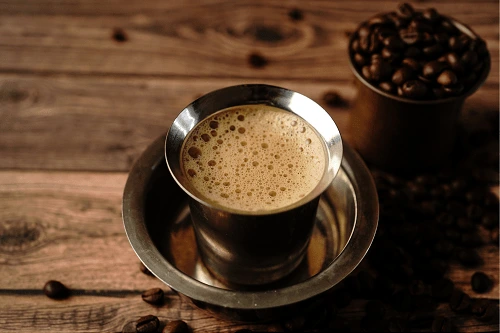Coffee, Coffee Recipes
How to Make South Indian Filter Coffee
Introduction
South Indian filter coffee, also known as “KAAPI,” or “Madras filter coffee,” is a popular and traditional coffee preparation method that originated in the southern regions of India. South Indian filter coffee is an integral part of the South Indian culture and is often enjoyed with breakfast or as an afternoon pick-me-up. The brewing process and serving style contribute to the unique experience of savoring this traditional coffee.
The popularity
Coffee has long been a beloved beverage in India, with a diverse range of coffee cultures and brewing methods found throughout the country. Among these, South Indian filter coffee stands out for its distinct taste and preparation technique. The popularity of Indian filter coffee has grown exponentially, both within India and internationally, captivating coffee aficionados with its rich aroma and flavorful experience.
The Origin and History of South Indian Filter Coffee
Coffee’s arrival in India
The history of coffee in India can be traced back to the 16th century when it was introduced by the Sufi saint Baba Budan. He smuggled seven coffee beans from Yemen and planted them in the hills of Chikmagalur, Karnataka, marking the beginning of coffee cultivation in India.
The influence of South Indian coffee culture
South India has been a hub for coffee cultivation and consumption for centuries. The coffee estates in regions like Karnataka, Kerala, and Tamil Nadu have played a significant role in shaping the coffee culture of India. The tradition of brewing coffee using a filter apparatus originated in this region and has since spread to other parts of the country.
Regional Variations of Indian Filter Coffee
Indian filter coffee holds a special place in the hearts of coffee enthusiasts across the country. Its unique brewing methods and distinct flavors have made it a beloved beverage for generations. One of the fascinating aspects of Indian filter coffee is the regional variations that have developed over time. In this article, we will explore the different styles of Indian filter coffee found in the southern regions of India.
The Charm of South Indian Filter Coffee
South Indian filter coffee, often referred to as “degree coffee,” is a cherished tradition in households and traditional coffee houses across the southern regions of India. This aromatic beverage is known for its strong flavor, creamy texture, and the perfect balance of bitterness and sweetness. Let’s dive deeper into the regional variations of this delightful brew.
KAAPI in Karnataka: A Cultural Delight
In the state of Karnataka, filter coffee is affectionately known as “KAAPI.” The brewing process and presentation of KAAPI are similar to South Indian filter coffee, with a strong emphasis on maintaining the authentic taste and experience. One significant difference lies in the serving vessels used. KAAPI is traditionally served in a brass tumbler and DABARA/DAVARA, adding a touch of cultural charm to the coffee-drinking ritual. The rich aroma and unique flavors of KAAPI make it a favorite among locals and tourists alike.
Madras Filter Coffee: A Taste of Chennai
The bustling city of Chennai, formerly known as Madras, is renowned for its distinct style of filter coffee. Madras filter coffee has gained a reputation for its unique taste and brewing technique. It is known for its strong decoction, which is a concentrated coffee extract. The secret lies in the blend of coffee beans, roasted to perfection, and the meticulous filtering process. The decoction is then mixed with hot milk, striking the ideal balance between the flavors of coffee and milk. When served, Madras filter coffee forms a delightful layer of foam on top, enhancing the overall sensory experience. Traditionally, it is served in a stainless steel tumbler and davarah, giving it an authentic touch.
The Key Ingredients
To make a delicious cup of South Indian Filter Coffee, you will need the following ingredients:
- Freshly roasted coffee beans: The quality and roast level of the coffee beans play a crucial role in determining the flavor of the coffee.
- Chicory: Traditionally, South Indian Filter Coffee includes a small amount of chicory, which adds a unique taste and aroma to the brew.
- Filtered water: The quality of water used affects the overall taste of the coffee.
- Milk
- Sugar
The Process of Making South Indian Filter Coffee
- Start by grinding the coffee beans and chicory together to a medium-coarse consistency. This ensures the right extraction of flavors during the brewing process.
- Assemble the stainless steel coffee filter by placing the perforated disc, coffee powder, and compacting it with the pressing disc.
- Rinse the filter with hot water to pre-heat it, which helps in maintaining the temperature during the brewing process.
- Add the coffee powder to the pre-heated filter and gently tap it to level the surface.
- Place the upper chamber on top of the filter and ensure a tight fit.
- Pour hot water into the upper chamber, allowing it to slowly percolate through the coffee powder and collect in the bottom chamber.
- Allow the coffee to brew for a few minutes until all the water has passed through the filter and collected in the bottom chamber.
- The collected coffee decoction in the bottom chamber is the concentrated essence of South Indian Filter Coffee.
- In a separate container, mix a small amount of coffee decoction with hot milk in a 3:1 ratio.
- To create a frothy layer, pour the coffee back and forth between two containers or use a traditional DABARA and tumbler set.
- Pour the brewed coffee into stainless steel or brass cups from a height to create a frothy layer on top. Serve alongside some traditional South Indian snacks for the complete experience.
The Art of Serving
It is traditionally served in a tumbler and DABARA/DAVARA set, which consists of a stainless steel tumbler and a wide-mouthed container called a DABARA/DAVARA. The coffee is poured back and forth between the tumbler and DABARA to create a frothy layer and enhance its taste. The height at which the coffee is poured plays a crucial role in achieving the perfect froth.
Tips and Tricks for a Perfect Cup
- Use freshly roasted coffee beans for the best flavor.
- Adjust the coffee-to-chicory ratio according to your preference. For a stronger taste, increase the amount of coffee.
- Experiment with the water-to-coffee ratio to find your desired strength.
- Froth the coffee vigorously to create a rich, creamy texture.
- Serve the coffee hot to enjoy its full aroma and flavor.
Health Benefits of South Indian Filter Coffee
It offers several health benefits when consumed in moderation. It contains antioxidants and may help reduce the risk of certain diseases, such as Parkinson’s disease, liver cancer, and type 2 diabetes. The presence of chicory in the coffee may aid digestion and improve gut health.
The popularity and global recognition of Indian filter coffee
Over the years, Indian filter coffee has gained significant popularity beyond the borders of India. Its distinct flavors, rich aroma, and unique brewing process have captivated coffee enthusiasts worldwide. Indian filter coffee has become a part of specialty coffee menus in cafes around the globe, showcasing its cultural significance and appreciation for traditional brewing methods.
Conclusion
It is a beloved beverage that combines the flavors of freshly brewed coffee and creamy milk. With its unique brewing method and rich taste, it has become an integral part of South Indian culture. By following the steps outlined in this article, you can experience the joy of making and savoring a perfect cup of South Indian Filter Coffee.
Frequently Asked Questions (FAQs)
- Is it stronger than regular coffee? It is known for its intense flavor, but the strength can be adjusted based on personal preference.
- Can I use instant coffee to make South Indian Filter Coffee? Traditional South Indian Filter Coffee is made using freshly ground coffee beans, but you can experiment with instant coffee as well.
- How do I clean the coffee filter? After each use, rinse the filter with warm water and let it air dry. Avoid using harsh detergents or scrubbing pads that can damage the filter.
- Can I make it without chicory? While chicory adds a distinct flavor to the coffee, you can make it without chicory if you prefer a milder taste.
- Can I use dairy-free milk alternatives? Yes, you can use dairy-free milk alternatives such as almond milk or soy milk to make a vegan version of South Indian Filter Coffee.

